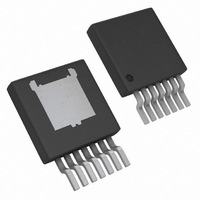LM22677TJE-5.0/NOPB National Semiconductor, LM22677TJE-5.0/NOPB Datasheet - Page 8

LM22677TJE-5.0/NOPB
Manufacturer Part Number
LM22677TJE-5.0/NOPB
Description
IC REG SWITCH BUCK 5A 5V TO263-7
Manufacturer
National Semiconductor
Series
SIMPLE SWITCHER®r
Type
Step-Down (Buck)r
Datasheet
1.LM22677TJE-ADJNOPB.pdf
(16 pages)
Specifications of LM22677TJE-5.0/NOPB
Internal Switch(s)
Yes
Synchronous Rectifier
No
Number Of Outputs
1
Voltage - Output
5V
Current - Output
5A
Frequency - Switching
200kHz ~ 1MHz
Voltage - Input
4.5 ~ 42 V
Operating Temperature
-40°C ~ 125°C
Mounting Type
Surface Mount
Package / Case
TO-263-7 Thin
Primary Input Voltage
12V
No. Of Outputs
1
Output Voltage
5V
Output Current
5A
No. Of Pins
7
Operating Temperature Range
-40°C To +125°C
Msl
MSL 1 - Unlimited
Filter Terminals
SMD
Rohs Compliant
Yes
For Use With
551600233-001 - WEBENCH BUILD IT LM2267X TO-263LM22677EVAL - BOARD EVALUATION FOR LM22677
Lead Free Status / RoHS Status
Lead free / RoHS Compliant
Power - Output
-
Other names
LM22677TJE-5.0TR
Available stocks
Company
Part Number
Manufacturer
Quantity
Price
Part Number:
LM22677TJE-5.0/NOPB
Manufacturer:
NS/国半
Quantity:
20 000
www.national.com
The percentage of output current limit fold back is affected by
duty
See
The current limit will only protect the inductor from a runaway
condition if the LM22677 is operating in its safe operating
area. A runaway condition of the inductor is potentially catas-
trophic to the application. For every design, the safe operating
area needs to be calculated. Factors in determining the safe
operating area are the switching frequency, input voltage,
output voltage, minimum on-time and feedback voltage dur-
ing an over current condition.
As a first pass check, if the following equation holds true, a
given design is considered in a safe operating area and the
current limit will protect the circuit:
If the equation above does not hold true, the following sec-
ondary equation will need to hold true to be in safe operating
area:
If both equations do not hold true, a particular design will not
have an effective current limit function which might damage
the circuit during startup, over current conditions, or steady
state over current and short circuit condition. Oftentimes a
reduction of the maximum input voltage or a reduction of the
switching frequency will bring a design into the safe operating
area.
When synchronized to an external sync pulse, the LM22677
will not fold back the switching frequency in an over current
condition.
Soft-Start
The soft-start feature allows the regulator to gradually reach
the initial steady state operating point, thus reducing start-up
stresses and surges. The soft-start is fixed to 500 µs (typical)
start-up time and cannot be modified.
Figure 2
cycle,
FIGURE 2. Output Current in Foldback vs.
for details.
V
inductance,
IN
x T
Nominal Duty Cycle
BLK
x F < V
and
OUT
x 0.724
switching
30074150
frequency.
8
Switching Frequency Setting and
Synchronization
There are three different modes for the RT/SYNC pin. It can
be left floating for a 500 kHz switching frequency.
A resistor from the RT/SYNC pin to ground can be used to
adjust the switching frequency between 200 kHz and 1 MHz.
An external synchronization pulse can be applied to the RT/
SYNC pin for switching frequencies up to 1 MHz. The syn-
chronizing frequency must be greater than the internal switch-
ing frequency for proper operation. The maximum internal
switching frequency is guaranteed in the Electrical Charac-
teristics table. The LM22677 internally sets the RT/SYNC
mode during start up.
Many applications are limited to lower switching frequencies
due to minimum on-time and minimum off-time requirements
as well as increased switching losses at switching frequen-
cies higher than 500 kHz. In case of synchronizing to an
external sync pulse, the clock pulse must be in a valid low or
high state when the LM22677 starts up and can be applied
after device regulation. The internal oscillator will synchronize
to the external sync pulse rising edge. If the external sync
pulse is disconnected the LM22677 switching frequency will
return to default 500 kHz (typ.).
When operating at frequencies above 500 kHz, external com-
ponents such as the inductor and the output capacitors can-
not be reduced dramatically. This is due to the fixed internal
compensation and stability requirements. Running the
LM22677 at frequencies higher than 500 kHz is intended for
applications with EMI or beat frequency concerns. The flexi-
bility of increasing the switching frequency above 500 kHz can
be used to operate outside a critical signal frequency band of
an application. This can also be used to set multiple switchers
in an application to the same frequency to reduce beat fre-
quencies and simplify filtering.
See the current limit section of this datasheet for information
about the safe operating area. When synchronizing to an ex-
ternal synchronization pulse, the LM22677 will not fold back
the switching frequency in an over current condition.
The typical curve below shows adjusted switching frequen-
cies with different frequency set resistors from the RT/SYNC
pin to ground.
FIGURE 3. Switching Frequency vs RT/SYNC Resistor
30074113













